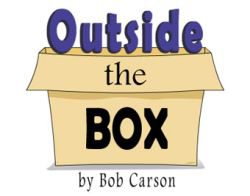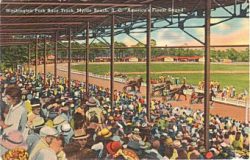Time Machine
November 18, 2019,Editor’s Note: The USTA website is pleased to present freelance writer Bob Carson and his popular “Outside the Box” features. This monthly series is a menu of outlandish proposals presented with a wink — but the purpose behind them is serious. The views contained in this column are that of the author alone, and do not necessarily represent the opinions or views of the United States Trotting Association.
Time travel is a fascinating trip. Let us travel backward in time to 33° 44′ 38.67″ N, 78° 52′ 10.11″ W. Each of our three stops will begin at noon on April 12 and last for one hour. At each stop, we will find horses. With a whoosh, a shudder and a kaleidoscope of flashing of lights, we are off to our first stop into the mists of bygone days.
April 12, 1899: We step out of our machine into bright sunshine and smell the sea breeze. We squint as we look around and see a tiny rural community on the shores of an Ocean. We stroll over to a shack. A man wearing loose-fitting overalls and a straw hat with an unlit corncob pipe in his teeth loads a barrel into a two-wheeled cart hooked to a small brown mare.
We ask him, “What’s the name of this town?”
 He pats the mare on her rump and with a slow, southern drawl says, “Well, that depends, some call us Long Bay, some say Withers, others use Withers Big Swamp, but mostly we be called New Town.”
He pats the mare on her rump and with a slow, southern drawl says, “Well, that depends, some call us Long Bay, some say Withers, others use Withers Big Swamp, but mostly we be called New Town.”
It would be a few years until a newspaper sponsored a contest to name the town. Mrs. F. E. Burroughs, the wife of the founder of Burroughs & Collins, won the contest by submitting the name “Myrtle Beach.” She chose the name because of the wax myrtle trees growing wild along the shore beaches of Horry County, South Carolina.
The Burroughs & Collins Company, a timber/turpentine company, was beginning to purchase land and make inroads into the peaceful, beautiful land that remained sparsely uninhabited due to the county’s geographical inaccessibility and poor economy. Horses did the work. Horses transported the citizens.
The Conway & Seashore Railroad began daily service on May 1, 1900. In a few years, the company built the beach’s first hotel, The Seaside Inn, and began to sell oceanfront lots for $25. Buyers were entitled to an additional lot if they built a house valued at over $500.
We enjoy our hour, the languid pace among the spattering of residents, the rustic structures and the continuous thump of waves crashing against the virgin shoreline. We step back into our time machine and push the lever to whisk us to our next stop in time.
April 12, 1929: We step out to our location on the rim of the Atlantic Ocean. We view a man-made wonder, a stunning, white palatial hotel with towers reaching into the blue sky. We gasp at the building with marble staircases flowing down to green manicured lawns. In the distance, we see a spectacular golf course. We gawk as a parade of horse-drawn carriages transfer passengers from the train depot to the hotel. In less than 30 years, the sleepy speck of shoreline has transformed into splendor.
The hotel and golf course, named Ocean Forest, was the first phase of an even more ambitious project called Acadia. John T. Woodside, the driving force behind the project, was the oldest, and most famous of four brothers from Greenville, S.C. John T. Woodside owned banks, cotton mills, insurance companies, and real estate. In 1924, he had just completed the magnificent Poinsettia Hotel in Greenville. Perhaps this whetted his appetite for his next project. He purchased 65,000 acres of land and 12 miles of coastline from Myrtle Beach Farms and began construction of a ten-story, Georgian-style, high-rise, beachfront hotel, that was not just a hotel, but a citadel of luxury. We move ahead in time.

Washington Park Harness Race Track, located in Myrtle Beach at Twenty-First Avenue and Oak Street. Painting reprint courtesy of Chapin, S.C., Memorial Library.
April 12, 1939: We step out of our time machine into Washington Park Harness Race Track, located in Myrtle Beach at Twenty-First Avenue and Oak Street. Paul and Parrot Hardy, two brothers from Mullins, S.C., leased the property and built the racetrack. The construction cost $40,000 and the steel grandstands held 5,000 spectators. On the opening day of June 3, 1938, the grandstands were full.
In those grandstands, race fans had a clear view of the racing horses from start to finish with the Atlantic Ocean as a backdrop. Racing fans and dignitaries watched three races of three heats each. In November, later in the year, the South Carolina Coastal Exposition would come to Myrtle Beach with showgirls, bands, variety acts and, of course, harness racing.
Stabled on the grounds are horses from five states. They race around the half-mile oval with a white inner rail each Wednesday and Saturday afternoon all summer long.
Myrtle Beach enjoyed harness racing, but wagering was always a problem in South Carolina. Despite the excellent reputations of the Hardy Brothers and attempts to try several forms of gambling to stem the anti-gambling tide, the anti-gambling forces prevailed. Washington Park Race Track had a run of merely nine years. The end came in 1947 when South Carolina associate Supreme Court Justice G. Dewey Oxner ruled against wagering. The racehorses have never returned.
We walk away from the lively racetrack filled with happy spectators and the sound of pounding hooves and step into our machine to return to the present day, memories etched in our minds.
Today: Like sandcastles melting into the rising tide, every place, every person, and every horse we met on our journey through time has disappeared. Few current residents have heard of the Burroughs & Collins Company. Only the historically inclined know that once upon a time there was a palatial Ocean Forest Hotel or a magnificent Ocean Forest Golf Course. Perhaps a few elderly residents vaguely remember the pounding hooves and the roaring crowds as harness horses raced around Washington Park.
Tomorrow: Always a question. Here is another question. Why can’t harness racing return?
• In the 70 years since the anti-gambling forces slammed the door on Washington Park, a new generation of citizens and politicians have emerged.
• Anti-gambling states face a tide of irrelevance in a digital world. What is relevant is the need for new revenue streams on the state and city levels.
• The weather is still beautiful, visitors flock to the area, and the population is dense.
• There is no competition from any professional sports franchises in the state of South Carolina.
• Harness racing would be a unique form of entertainment with a fresh start in virgin territory.
We need a modern-day Paul and Parrot Hardy to take the reins.

